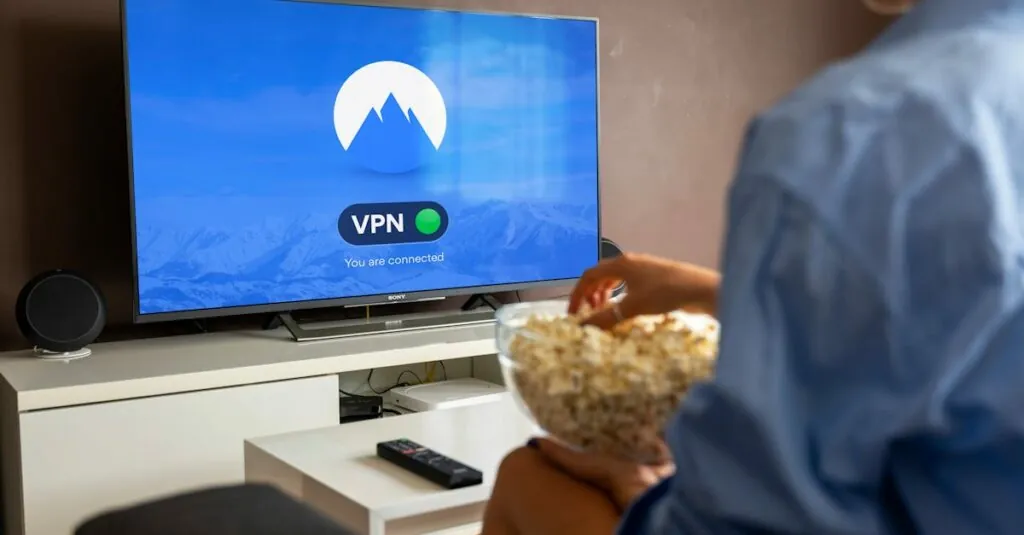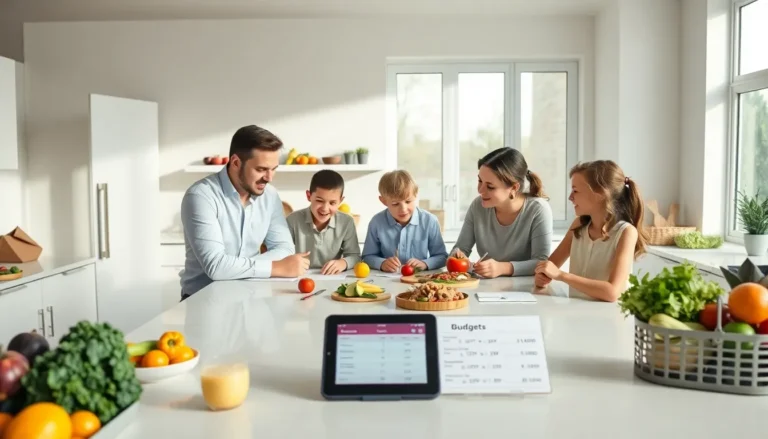Table of Contents
TogglePicture this: you’re lounging on your couch, scrolling through your iPhone, and suddenly you spot that must-see video or binge-worthy series. But wait—why squint at your tiny screen when you can cast it to your Roku TV and enjoy it in all its glory? It’s like upgrading from a snack-sized candy bar to an entire chocolate cake.
Understanding Roku TVs
Roku TVs represent a popular choice for streaming enthusiasts. These smart TVs integrate the Roku platform, allowing users access to a wide array of streaming services. Both Netflix and Hulu exemplify popular apps available through Roku.
The operating system provides a user-friendly interface. Navigation remains intuitive, enabling users to find favorite shows and movies easily. Remote control features enhance the viewing experience, with shortcuts for one-touch access to apps.
Multiple screen sizes cater to diverse preferences and room configurations. Ranging from 32 inches to over 75 inches, Roku TVs can fit in various spaces. Users often appreciate options for both budget-friendly and high-end models to suit their needs.
Casting content from devices enhances the versatility of Roku TVs. iPhones, Android phones, and tablets connect seamlessly. This casting feature brings personal content from small screens to large displays.
Reliability plays a significant role in the overall functionality of Roku TVs. Regular software updates ensure optimal performance and security. Supported by a large community of users, troubleshooting resources are readily available.
Various Roku TV brands coexist in the market. TCL, Hisense, and Sharp stand out as leading manufacturers, each offering different models with unique features. Customers choose based on performance, price point, and user reviews.
Roku TVs also support voice control capabilities. Integration with smart home devices enhances user comfort and accessibility. Voice commands streamline the process of finding content and controlling playback, further enhancing the viewing experience.
Setting Up Your Roku TV
Setting up a Roku TV involves a few straightforward steps that ensure smooth streaming from devices like an iPhone. Follow these instructions to make the connection seamless.
Connecting to Wi-Fi
Connecting your Roku TV to Wi-Fi remains essential for streaming. First, navigate to the Home screen by pressing the Home button on the remote. Then, select Settings, choose Network, and click on Setup Connection. Opt for Wireless, and the Roku TV will scan for available networks. Users should select their home Wi-Fi network from the list. Enter the Wi-Fi password using the on-screen keyboard. After inputting the password, click Connect to establish the connection. Your Roku TV will confirm that it is connected to the internet, allowing access to streaming services and apps.
Updating Software
Keeping the software updated ensures optimal performance. To check for updates, navigate to Settings from the Home screen. Select System, followed by System Update. Click on Check Now to see if an update is available. If an update exists, the Roku TV will prompt the user to download and install it. Installing updates enhances features, improves security, and fixes bugs, ensuring a smooth streaming experience. Regular updates help maintain compatibility with streaming services, providing access to the latest content and technology.
Preparing Your iPhone
Preparing your iPhone for casting to a Roku TV involves a few simple steps.
Ensuring Compatibility
First, check that both the Roku TV and the iPhone are connected to the same Wi-Fi network. A compatible Roku device, such as a Roku Streaming Stick or Roku TV model, makes this process straightforward. iPhones running iOS 12 or later support screen mirroring to Roku devices, so ensure the device is updated. Updating the iOS can usually resolve any connectivity issues. Additionally, verify that the Roku device has the latest software installed for improved performance.
Enabling Screen Mirroring
Enabling screen mirroring on both devices helps create a seamless casting experience. On your iPhone, navigate to ‘Settings’ and select ‘Wi-Fi’ to ensure the correct network is active. Next, swipe down from the top-right corner of the screen to access the Control Center. Tap on ‘Screen Mirroring’ to view available devices. Choose the Roku TV from the list to start the connection. Confirm on the Roku TV if prompted, and the casting setup will be complete. This allows effortless streaming of videos, photos, and other content from the iPhone to the larger screen.
Casting to Your Roku TV
Casting from an iPhone to a Roku TV enhances the viewing experience by utilizing the right tools and settings.
Using the Roku App
Start by downloading the Roku app from the App Store. This app acts as a remote control and includes casting features. Open the app and connect it to the Roku TV, ensuring both devices are on the same Wi-Fi network. Users can browse their mobile content and select what they want to cast. Tap the “Cast” icon to send videos, photos, or music to the larger screen. Enjoy watching with your friends or family, as this method provides a simple interface for sharing media.
Casting via AirPlay
AirPlay brings another convenient option for streaming. Ensure that both the iPhone and the Roku TV support AirPlay 2 functionality. On the iPhone, access the Control Center and select “Screen Mirroring.” Choose the Roku TV from the list of available devices. Following that, content instantly appears on the TV screen. This method allows seamless playback of various media types, from movies to presentations, making it ideal for both entertainment and work purposes.
Troubleshooting Common Issues
Casting from an iPhone to a Roku TV can occasionally present challenges. Connection problems often arise when both devices aren’t on the same Wi-Fi network. Verifying the Wi-Fi settings can resolve this issue quickly.
Sometimes, the Roku TV may not appear in the iPhone’s Screen Mirroring settings. Restarting both the iPhone and the Roku TV can refresh their connections, making devices detectable again.
Errors might occur if the iPhone isn’t updated to the latest iOS version. Ensuring the device is running iOS 12 or later is essential for compatibility.
Frequent disconnections during casting can be frustrating. Positioning the router closer to the devices may improve signal strength. Reducing interference from other electronic devices also helps maintain a stable connection.
User frustration often stems from poor video quality while casting. Checking the internet speed can clarify if the connection supports streaming quality. A minimum speed of 3 Mbps is recommended for smooth playback.
Users may experience audio delays during streaming. Adjusting audio settings on the Roku TV can help enhance synchronization.
Sometimes, apps might not support casting. It’s vital to use compatible applications like Netflix or Hulu. Checking the app’s settings for casting options ensures a smoother experience.
For persistent issues, resetting the Roku TV can often restore functionality. Navigating to the settings allows for a factory reset, returning all software options to default.
Casting from an iPhone to a Roku TV opens up a world of entertainment possibilities. With the right setup and a few simple steps users can effortlessly enjoy their favorite content on a larger screen. The combination of Roku’s user-friendly interface and the iPhone’s versatility makes for a seamless viewing experience.
By following the guide provided and utilizing the Roku app or AirPlay users can enhance their streaming sessions. Troubleshooting tips ensure that any hiccups along the way can be easily resolved. Ultimately this method transforms how content is consumed bringing family and friends together for shared moments of enjoyment.





